Shankill Road

The Shankill Road [1] is one of the main roads leading through west Belfast, Northern Ireland. It runs through the predominantly loyalist working class area known as the Shankill. The road stretches westwards for about 2.4 km (1.5 mi) from central Belfast and is lined, to an extent, by shops. The residents live in the many streets which branch off the main road. The area along the Shankill Road forms part of Court district electoral area.
History
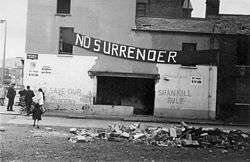
The first Shankill residents lived at the bottom of what is now known as Glencairn: a small settlement of ancient people inhabited a ring fort, built where the Ballygomartin and Forth rivers meet.[2]
A settlement around the point at which the Shankill Road becomes the Woodvale Road, at the junction with Cambrai Street, was known as Shankill from the Irish Seanchill meaning 'old church'. Believed to date back to 455 CE,[3] it was known as the "Church of St Patrick of the White Boy" and in time had six smaller churches, known as "alterages", attached to it across the west bank of the River Lagan.[4] The church was an important site of pilgrimage and it is likely that the ford of the River Farset, which later became the core of Belfast, was important because of its site on the pilgrimage route.
As a paved road the Shankill dates back to around the sixteenth century as at the time it was part of the main road to Antrim, a role now filled by the A6.[5] The lower sections of the Shankill Road were in former times the edge of Belfast with both Boundary Street on the lower Shankill and Townsend Street in the middle Shankill taking their names from the fact that at the time they were built they marked the approximate end of Belfast.[6]
The area expanded greatly in the mid to late 19th century with the growth of the linen industry. Many of the streets in the Shankill area, such as Leopold Street, Cambrai Street and Brussels Street, were named after places and people connected with Belgium or Flanders, where the flax from which the linen was woven was grown. The linen industry, along with others that had previously been successful in the area, declined in the mid-20th century leading to high unemployment levels, which remain at the present time. The Harland and Wolff shipyard, although on the other side of Belfast, was also a traditional employer for the area,[7] and it too has seen its workforce numbers decline in recent years.
The area was also a regular scene of rioting in the nineteenth century, often of a sectarian nature after Irish Catholic areas on the Falls Road and Ardoyne emerged along with the city's prosperity.[8] One such riot occurred on 9 June 1886 following the defeat of the Government of Ireland Bill 1886 when a crowd of around 2,000 locals clashed with Royal Irish Constabulary police attempting to stop the mob from looting a liquor store. Local law enforcement officers had to barricade themselves in Bower's Hill barracks where a long siege followed.[9] Bower's Hill was a name applied to the area of the road between Agnes Street and Crimea Street.[10]
The West Belfast Division of the original Ulster Volunteer Force organised on the Shankill and drilled in Glencairn and many of its members saw service in the First World War with the 36th (Ulster) Division.[11] A garden of remembrance beside the graveyard and a mural on Conway Street commemorate those who fought in the war. Recruitment was also high during the Second World War and that conflict saw damage occur to the Shankill Road as part of the Belfast Blitz when a Luftwaffe bomb hit a shelter on Percy Street, killing many people. The site of the destruction was visited by the Duke and Duchess of Gloucester soon after the attack.[12]
The Troubles

During the Troubles, the Shankill was a centre for loyalist paramilitarism. The modern Ulster Volunteer Force (UVF) had its genesis on the Shankill and its first attack occurred on the road on 7 May 1966 when a group of UVF men led by Gusty Spence petrol bombed a Catholic-owned pub. Fire also engulfed the house next door, killing the elderly Protestant widow, Matilda Gould (77), who lived there.[13] This was followed on 27 May by the murder of John Scullion (28), a Catholic, as he walked home from a pub.[14] On 26 June a Catholic civilian, Peter Ward (18), a native of the Republic of Ireland, was killed and two others wounded as they left a pub on the Shankill's Malvern Street.[13] Shortly after this attack, Spence and three others were arrested and later convicted.[15] The UVF would continue to be active on the Shankill throughout the Troubles, most notoriously with the Shankill Butchers led by Lenny Murphy, as well as the likes of William Marchant and Frankie Curry, the latter a member of the Red Hand Commando.

Similarly the Ulster Defence Association, established in September 1971, also began on the Shankill when vigilante groups such John McKeague's Shankill Defence Association and the Woodvale Defence Association merged into a larger structure.[16] Under the leadership of initially Charles Harding Smith and later Andy Tyrie the Shankill Road became the centre of UDA activity with the movement establishing its headquarters on the road and leading members such as James Craig, Davy Payne and Tommy Lyttle making their homes in the area. The Shankill was covered by the West Belfast Battalion of the UDA which was divided into three companies A (Glencairn and Highfield), B (middle Shankill) and C (lower Shankill).[17] During the 1990s C Company under Johnny Adair became one of the most active units in the UDA with gunmen such as Stephen McKeag responsible for several murders.[18] C Company would later feud with both the UVF and the rest of the UDA until 2003 when they were forced out.[19] Following the exile of Adair and his supporters, as well as the murder of some such as Alan McCullough, the lower Shankill UDA was once again brought into line with the rest of the movement under former Adair supporter Mo Courtney.[20]
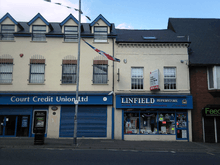
The Greater Shankill and its residents were also subjected to a number of bombings and shootings by Irish republican paramilitary forces. During 1971 two pub bombings took place on the Shankill, one in May at the Mountainview Tavern at which several people were injured and a second at the Four Step Inn in September which resulted in two deaths.[21] A further bomb exploded at the Balmoral Furnishing Company on 11 December that same year, resulting in four deaths, including two infants.[22] Another pub attack followed on 13 August 1975 when the IRA opened fire on patrons outside the Bayardo Bar and then left a bomb inside the crowded bar area, killing four civilians and one UVF member. Brendan McFarlane was given a life sentence for his part in the attack.[23]
The Shankill Road bombing occurred on 23 October 1993. A bomb exploded in Frizzell's Fish Shop, below the UDA's Shankill headquarters. The bomb exploded prematurely as it was being planted. Nine people were killed in addition to one of the bombers, Thomas Begley. None of the loyalist paramilitaries targeted were hurt, as they had postponed a planned meeting. Begley's accomplice, Sean Kelly, survived and was imprisoned.

Areas of the Shankill Road
Lower Shankill
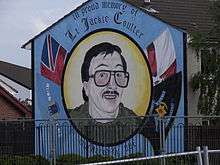
The Shankill Road begins at Peter's Hill, a road that flows from North Street in Belfast city centre and quickly merges into the Shankill itself at the Westlink. Peter's Hill is adjacent to the Unity Flats/Carrick Hill, a small nationalist area to the north of the city centre. The area of housing on the lower Shankill around Agnes Street was known colloquially as "The Hammer", one of a number of nicknames applied to districts that included "the Nick".[24] The Hammer name is recalled in the Hammer Sports Complex, the home ground of amateur football side Shankill United F.C.[25] The Lower Shankill has been redeveloped in recent years although during the 1960s the housing was ranked as the worst in Belfast.[26] A Lower Shankill Community Association is active in the area whilst the Shankill Leisure Centre is also located here.[27] The Shankill Women' s Centre, a women's educational initiative established by May Blood (now Baroness Blood) in 1987, is also located on the lower Shankill.[28] George McWhirter, a writer and first Poet Laureate of Vancouver, B.C., Canada, also came from the area originally.
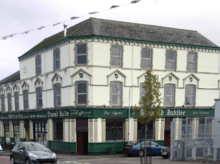
Several streets link the Shankill Road to the neighbouring Crumlin Road with the area around North Boundary Street formerly the stronghold of Johnny Adair's C Company. Several members of C Company who have died are commemorated on murals around the area, notably Stephen McKeag, William "Bucky" McCullough, who was killed by the Irish National Liberation Army (INLA) in 1981 as part of a series of tit for tat murders between that group and the UDA[29] and Jackie Coulter, killed by the UVF during a loyalist feud in 2000.[30] The Shankill theoretically links to the neighbouring Falls Road at a few locations although most of these exits are blocked by peace lines. The entrance at Northumberland Street is sometimes open although it has lockable gates at the midpoint.
The Lower Shankill is home to many loyalist pubs, the most notable being the "Malvern Arms", associated with the UVF, and the "Diamond Jubilee" – a UDA haunt which became notorious as the main meeting place of "C Company" during the early 1990s. The "Long Bar" and the "Windsor Bar", both frequented by the UVF in the 1970s, have since vanished. According to investigative journalist Martin Dillon, the latter was used a centre of operations for a UVF platoon led by Anthony "Chuck" Berry.[31]
Middle and upper Shankill
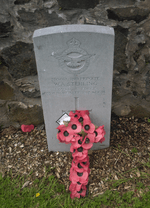
Although there is no precise dividing line between the Lower, Middle and Upper Shankill locally it is usually said that the lower Shankill ends at Agnes Street.[32] The area was redeveloped some time before the lower Shankill leading to feelings locally that those in the upper part of the road were better off compared to the "Apaches" of the lower Shankill as they were colloquially known.[33] A number of Protestant churches are situated in this area including the West Kirk Presbyterian Church,[34] the Shankill Methodist church and the independent Church of God.[35]
The West Belfast Orange Hall is located near the top of the road. This building, which houses the No. 9 District Orange Lodge, has been revamped by Belfast City Council.[36] The same is true of the nearby Shankill Cemetery, a small graveyard that has received burials for around 1000 years. The graveyard is noted for a statue of Queen Victoria as well as the adjacent memorial to the members of the 36th Ulster Division who died at the Battle of the Somme.[37] Amongst those buried in the graveyard is Rev Isaac Nelson, a Presbyterian minister who was also active in nationalist politics. Nelson lived at Sugarfield House on the Shankill, which has since given its name to Sugarfield Street.[38] Also buried here is 2nd Private W.A. Sterling, killed in action with the Royal Air Force on 5 November 1918 at the age of 14.
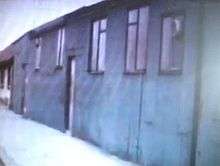
The area includes Lanark Way, one of the few direct links to the neighbouring nationalist areas, which leads directly to the Springfield Road (although the street is gated close to the Springfield Road end and these are locked at night). A regular route for UDA gunmen seeking access to the Falls during the Troubles, it was dubbed the "Yellow Brick Road" by Stephen McKeag and his men.[39]
A number of pubs frequented by UVF members were located in the area. These included the "Berlin Arms" at the Shankill and Berlin Street junction, and the "Bayardo", which was situated on the corner of Shankill and Aberdeen Street. The pub was close to "The Eagle" where the UVF "Brigade Staff" had their headquarters in rooms above a chip shop bearing the same name at the Shankill and Spiers Place junction. The "Brown Bear" pub which loyalist Lenny Murphy used as his headquarters to direct his notorious murder gang – the Shankill Butchers – was located on the corner of the Upper Shankill and Mountjoy Street.[40] The pub, which went out of business, has since been demolished. Another drinking den in the area used by Murphy and his gang was the "Lawnbrook Social Club" in Centurion Street. The "Rex Bar" on the middle Shankill is one of the oldest pubs on the Shankill Road and frequented by members of the UVF. This bar was attacked by members of the UDA's C Company in 2000 to launch a loyalist feud between the two groups.[41]
Greater Shankill
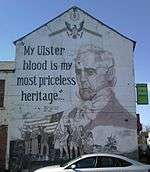
The term, "Greater Shankill", is used by a number of groups active in the area, most notably the Greater Shankill Partnership,[42] to refer to both the Shankill Road and the unionist/loyalist areas that surround it. The main areas identified within this area are Woodvale, Glencairn, and Highfield. The Greater Shankill as a whole has a population of around 22,000.
Woodvale
The Woodvale area begins after Ainsworth Avenue, when the road changes from Shankill Road to Woodvale Road. As well as extensive housing the Woodvale area contains the Woodvale Presbyterian Church, which building on the corner of the Woodvale and Ballygomartin Roads dates back to 1899.[43] The area takes its name from Woodvale Park, a public gardens and sports area that was opened in 1888.[44]
Also found locally is St. Matthew's Church of Ireland, which was rebuilt in 1872 and is named after the original church which had sat in the grounds of the graveyard. The architecture of this church is called trefoil, which means it is built in the shape of a shamrock. The shamrock is the national emblem of Ireland and was supposedly used by St. Patrick, the patron saint of Ireland to explain the Holy Trinity of Father, Son, and Holy Ghost. There is a book about the church which says that St. Matthew's is actually a copy of a church in Salonika, as the rounded "leaves" do not have the indentations of shamrock leaves. The water in the stone outside the front door was thought to cure warts and, certainly up to the 1990s, was considered to cure colic if a new, open, safety pin were thrown in. The oldest stone in the Shankill graveyard was known locally as the "Bullaun Stone" and was traditionally said to cure warts if the affected area were rubbed on the stone. It was removed to the grounds of St Matthews in 1911.[45]
Glencairn
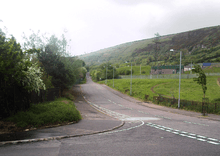
Glencairn is an area based around the Ballygomartin Road, which runs off the Woodvale Road, as well the Forthriver Road. It is bordered by the Crumlin Road. As well as a large housing estate the area also includes Glencairn Park, a large woodland area at the bottom of Divis Mountain. Previously the estate of the Cunningham family the area was open to the public in 1962.[46] The park features Fernhill House, the ancestral family home, which was not only used by Edward Carson to drill his Ulster Volunteers but was also the setting for the announcement of the Combined Loyalist Military Command (CLMC) ceasefire on 13 October 1994.[47] It subsequently became a museum but closed down in late 2010-early 2011. A further area of housing, known as the Lyndhurst area after a number of local streets, lies to the west of Glencairn Park (with the Glencairn estate to the east of the woodland area). The Lyndhurst area hit the headlines in 2003 when two leading loyalists, Jim Spence of the UDA and Jackie Mahood of the Loyalist Volunteer Force, were reported as brawling in the streets of the Lyndhurst area where they both lived.[48] The Ballygomartin Road extends as far as the nationalist Upper Whiterock Road although after Springmartin the area is mainly countryside.
The estate was the scene of the killings of two prominent loyalists. In 1982 Lenny Murphy was shot and killed by the Provisional IRA close to his girlfriend's house on the estate.[49] In 2001 William Stobie was killed by members of the UDA, a group to which Stobie had formerly belonged, after intimating that he would testify at a public inquiry into the death of Pat Finucane. Stobie's killing, which occurred near his home on Forthriver Road, was publicly claimed by the Red Hand Defenders, a cover name used by various loyalist groups on ceasefire.[50]
Highfield
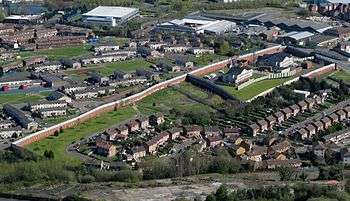
Highfield is a housing estate situated around the West Circular and Springmartin Roads, both of which run off the Ballygomartin Road. Highfield comes close to the nationalist Springfield Road and there is limited access between the two areas through West Circular and Springmartin. Due to its location parts of the area are sometimes known as the Springmartin estate.[51] Highfield is seen as an enclave and has been the scene of frequent sectarian tension.[52] As a consequence the Springmartin Road is home to an 18-foot-high (5.5 m) peace line that runs for the length of the road from the junction with the Springfield Road until near that with the Ballygomartin Road.[53] In May 1972 the area was the scene of a two-day gun battle between republican and loyalist paramilitaries and the British Army, although a combination of the peace lines and demographic changes meant that such open conflict was not repeated later in the Troubles.
Politics
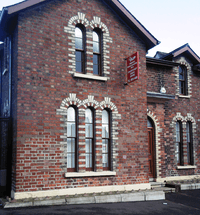
The Shankill has been traditionally unionist and loyalist, albeit with some strength also held by the labour movement. Belfast Shankill, covering the north-west part of the Shankill Road, was established as a constituency of the Parliament of Northern Ireland in 1929 and existed until the body was abolished in 1973. During that time the seat was held by three men, Tommy Henderson (1929–1953), Henry Holmes (1953–1960) and Desmond Boal (1960–1973). Of these only Holmes belonged to the mainstream Ulster Unionist Party for the entirety of his career with Boal a sometime member who also designated as both independent Unionist and Democratic Unionist Party and Henderson always and independent who for a time was part of the Independent Unionist Association. Henderson was a native of Dundee Street on the Shankill.[54] A Belfast Shankill constituency also returned a member to the Parliament of the United Kingdom from 1918–1922, with Labour Unionist Samuel McGuffin holding the seat. The areas south of the road were covered by the Belfast Woodvale seat at Westminster and a seat of the same name at Stormont. Robert John Lynn of the Irish Unionist Alliance represented the seat at Westminster for the entirety of its existence (1918–1922). The Stormont seat was held by John William Nixon (independent Unionist) from 1929 to 1950, Ulster Unionists Robert Harcourt (1950–1955) and Neville Martin (1955–1958), Billy Boyd of the Northern Ireland Labour Party until 1965 then finally John McQuade, who was variously Ulster Unionist, independent Unionist and Democratic Unionist until the seat was abolished in 1972.
The Shankill is currently part of the Belfast West constituencies for the Northern Ireland Assembly and Westminster. At the Assembly the Shankill is represented by four Sinn Féin MLAs and one each from the Social Democratic and Labour Party and the People Before Profit Alliance. At Westminster, since 1966, when the seat was lost by the last sitting unionist member Jim Kilfedder, it has also always had a nationalist or republican MP. The abstentionist policy of Sinn Féin MP Gerry Adams, who was West Belfast's MP until his resignation in 2011, led to an attempted legal challenge by local councillor Frank McCoubrey who argued that Shankill residents were being denied their right to representation.[55] The case was not a success.
On Belfast City Council the Greater Shankill area is covered by the Court electoral area. At the 2011 election the five councillors elected were William Humphrey, Naomi Thompson and Brian Kingston of the Democratic Unionist Party, the independent Frank McCoubrey (who is a member of the Ulster Political Research Group) and the Progressive Unionist Party's Hugh Smyth.[56]
Robert McCartney, who led his own UK Unionist Party and represented North Down at Westminster, is also originally from the Shankill.[57]
Education
Secondary schools serving the Shankill area include the Belfast Boys' Model School and Belfast Model School for Girls due to their location in the Ballysillan area of the neighbouring Crumlin Road. Pupils from the area also attend Hazelwood College or Malone College which are both integrated schools, as well as Victoria College and the Royal Belfast Academical Institution both of which are grammar schools. Prior to its closure, and before several changes of name, Cairnmartin Secondary School also served the greater Shankill area. Famous pupils include footballer Norman Whiteside[58] and boxer Wayne McCullough. The school, by then known as Mount Gilbert Community College, closed permanently in 2007 after a fall in pupil numbers.[59]
Primary schools in the greater Shankill area included Forth River Primary School on the Ballygomartin Road. Established in 1841, the original building was cramped and inspection reports over the years commented on the high standard of teaching despite the inadequacy of the building. During the 1980s and 1990s, closure and amalgamation were both suggested and vehemently opposed by everyone connected with the school. Ultimately a new £1.4m state-of-the-art school was announced as a replacement for the old building and this new school, which is on the adjacent Cairnmartin Road, was officially opened by Prince Andrew, Duke of York in 2005.[60] Others primary schools in the area include three on the Shankill Road itself in Glenwood Primary School, established in 1981,[61] Edenbrooke Primary School on Tennent Street and Malvern Primary School as well as Black Mountain Primary School and Springhill Primary School on Springmartin Road.
Sport
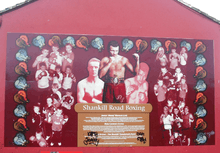
Wayne McCullough, a gold medalist at the Commonwealth Games and a world champion in the Bantamweight division and an olympic silver medalist at the 1992 Summer Olympics representing Ireland is a native of the Shankill. He is one of a number of boxers from the area to be featured on a mural on Gardiner Street celebrating the area's strong heritage in boxing.[62] The image has since been moved to Hopewell Crescent. McCullough trained in the Albert Foundry boxing club, located in the Highfield estate where he grew up.[63] Other locals to make an impact in the sport have included Jimmy Warnock, a boxer from the 1930s who beat world champion Benny Lynch twice, and his brother Billy.
Football is also a popular sport in the area with local teams including Shankill United, Albert Foundry, who play on the West Circular Road, Lower Shankill, who share the Hammer ground with United[64] and Woodvale who won the Junior Cup in 2011.[65] All four clubs are members of the Northern Amateur Football League. The main club in the area however is Linfield with a Linfield superstore trading on the Shankill Road despite the club being based on the Lisburn Road in south Belfast.[66] A Linfield Supporters and Social Club is situated on Crimea Street. An Ulster Rangers club is also open on the road, with the Glasgow club widely supported amongst Northern Irish Protestants. Norman Whiteside, the ex Northern Ireland and Manchester United midfielder, lived on the Shankill. Whiteside also lends his name to the Norman Whiteside Sports Facility, a community sports area used by Woodvale F.C.[67] The facility is located on Sydney Street West between the Shankill and the neighbouring Crumlin Road. George O'Boyle, who had a long career in Scottish football, is also a Shankill native.[68]
The Ballygomartin Road is also home to a cricket ground of the same name which in 2005 hosted a List-A match between Canada and Namibia in the 2005 ICC Trophy.[69] The ground is the home of Woodvale Cricket Club, established in 1887.[70]
Transport
Although the Shankill Road initially grew as part of the main road to Antrim it is no longer part of any wider network linking Belfast to neighbouring towns with its peripheral roads all either terminating in the mountains or linking to the Springfield Road. Belfast was served by a network of trams in the first half of the 20th century and the Shankill was the last part of the city to see this service removed in the 1950s.[71] Public transport is now provided by the Metro arm of Translink with the Shankill forming the eleventh of the company's twelve corridors. Buses link Belfast City Centre to the estates at the top of the Shankill as well as the Ballysillan area of the Crumlin Road.[72] Routes 11A/B and C follow each other up the Shankill Road and Woodvale Road as far as Woodvale Park. 11A continues straight on through Ardoyne, Crumlin Road, Bilston Road, Ballysillan Road and terminating at Silverstream (Ballysillan Park). 11B and C turn right onto Ballygomartin Road with 11B continuing to Springmartin and 11C turning right at Forthriver Road up to terminus at Glencairn which is at the top of the hill.
In popular culture
The Shankill area plays a prominent role in The Fall, in that Jimmy and Liz Tyler, grief counselling clients of Paul Spector's, as well as two of Spector's victims (Annie and Joseph Brawley) are shown to live there, as does a woman Spector meets on the train. Throughout the series, Spector, members of the police force, and other characters alike are beset by hostile residents of the neighbourhood, sometimes after having entered the neighbourhood and at other times when the residents have sought them out outside of the Shankill.
References
- ↑ PlaceNames NI: Shankill
- ↑ "What to do". Shankill Tourism. Retrieved 22 December 2013.
- ↑ "Shankill 455AD". Greater Shankill Partnership. Retrieved 22 December 2013.
- ↑ Hamilton, p. 1
- ↑ Hamilton, p.2
- ↑ Graham, Joe. "Belfast History". Rushlight Magazine. Retrieved 22 December 2013.
- ↑ Hamilton, p. 28
- ↑ McKittrick, David (23 August 2000). "Shankill Road was always tough, and it's getting tougher". London: independent.co.uk. Retrieved 10 June 2011.
- ↑ "The Belfast Riots of 1886". BBC.co.uk. Retrieved 10 June 2011.
- ↑ Hamilton, p. 9
- ↑ Hamilton, p. 14
- ↑ Hamilton, p. 19
- 1 2 "A Chronology of Key Events in Irish History 1800 to 1967". Cain.ulst.ac.uk. Retrieved 10 June 2011.
- ↑ Dillon, Martin. The Shankill butchers: the real story of cold-blooded mass murder. Routledge, 1999, pp. 20–23
- ↑ Taylor, Peter (1999). Loyalists. Bloomsbury Publishing. p. 44. ISBN 0-7475-4519-7.
- ↑ "Cain web Service: Abstracts on Organisations". cain.ulst.ac.uk. Retrieved 16 June 2010.
- ↑ McDonald & Cusack, UDA, p. 24.
- ↑ McDonald & Cusack, UDA
- ↑ McDonald & Cusack, UDA, pp. 370–73.
- ↑ McDonald & Cusack, UDA, pp. 390–99.
- ↑ Henry McDonald & Jim Cusack, UDA – Inside the Heart of Loyalist Terror, Dublin: Penguin Ireland, 2004, p. 8
- ↑ "A Chronology of the Conflict – 1971". CAIN.
- ↑ Taylor, Peter (1999). Loyalists. Bloomsbury Publishing. p. 149. ISBN 0-7475-4519-7.
- ↑ "Belfast Street Names Then And Now". Oldbelfastdistricts.rushlightmagazine.com. Retrieved 10 June 2011.
- ↑ "Hammer Sports Complex". Thenafl.co.uk. Retrieved 10 June 2011.
- ↑ McDonald & Cusack, UDA, p. 9
- ↑ "Shankill Leisure Centre". Belfastcity.gov.uk. Retrieved 10 June 2011.
- ↑ "Welcome to Shankill Women's Centre". Shankillwomenscentre.org.uk. 4 January 2011. Retrieved 10 June 2011.
- ↑ McDonald & Cusack, UDA, p. 119
- ↑ Funeral of murdered loyalist
- ↑ Dillon, p.40
- ↑ McDonald & Cusack, UDA, p. 332
- ↑ McDonald & Cusack, UDA, pp. 9–10
- ↑ "West Kirk site". Westkirk.org. Retrieved 10 June 2011.
- ↑ "Church of God site". Shankillcog.co.uk. Retrieved 10 June 2011.
- ↑ "Shankill Road". Belfastcity.gov.uk. Retrieved 10 June 2011.
- ↑ "Shankill graveyard". Belfastcity.gov.uk. Retrieved 10 June 2011.
- ↑ "Myths, Legends And Facts on Olde Belfast". Joegraham.rushlightmagazine.com. Retrieved 10 June 2011.
- ↑ McDonald &Cusack, UDA, p.227
- ↑ Taylor, Peter (1999). Loyalists. p.153
- ↑ Henry McDonald & Jim Cusack, UDA – Inside the Heart of Loyalist Terror, Penguin Ireland, 2004, pp. 325–327
- ↑ "Greater Shankill Partnership site". Greatershankillpartnership.org. Retrieved 10 June 2011.
- ↑ "Woodvale Presbyterian Church website". Woodvalepresbyterianchurch.com. Retrieved 10 June 2011.
- ↑ "Woodvale Park". Belfastcity.gov.uk. Retrieved 10 June 2011.
- ↑ Hamitlon, p. 1
- ↑ "Glencairn". Belfastcity.gov.uk. Retrieved 10 June 2011.
- ↑ McDonald & Cusack, UDA, pp. 274–275
- ↑ Loyalists in feud fight, The People
- ↑ McKittrick, David & McVea, David (2002). Making Sense of the Troubles: the story of the conflict in Northern Ireland. New Amsterdam Books. p.149
- ↑ Henry McDonald & Jim Cusack, UDA – Inside the Heart of Loyalist Terror, Penguin Ireland, 2004, pp. 310–311
- ↑ Film explores bonfire comradeship
- ↑ "Northern Ireland's grand plan to tackle sectarianism". Bbc.co.uk. 28 July 2010. Retrieved 10 June 2011.
- ↑ Interface No.6: Springmartin Road – Upper Ballygomartin Road
- ↑ Hamilton, p. 17
- ↑ "Adams may face court over 'forgotten constituents'". London: Guardian. 14 January 2003. Retrieved 10 June 2011.
- ↑ "Belfast City Council: Your Councillors by District Electoral Area". Minutes.belfastcity.gov.uk. Retrieved 10 June 2011.
- ↑ McCartney biography on CAIN
- ↑ Norman Whiteside, My Memories of Manchester United, 2003, p. 11
- ↑ BBC report on closure of Mount Gilbert
- ↑ "HRH the Duke of York officially opens Forth River Primary School, Belfast // Northern Ireland Office // Media Centre / Media Detail". Nio.gov.uk. Retrieved 10 June 2011.
- ↑ Glenwood Primary School: About our School
- ↑ "McCullough included in new mural". BBC News. 2 July 2009. Retrieved 10 June 2011.
- ↑ "Wayne McCullough". Culturenorthernireland.org. 15 April 2011. Retrieved 10 June 2011.
- ↑ "Lower Shankill". Thenafl.co.uk. Retrieved 10 June 2011.
- ↑ "Woodvale F.C. site". Woodvalefc.com. Retrieved 10 June 2011.
- ↑ "Linfield Superstore News". Linfieldfc.com. Retrieved 10 June 2011.
- ↑ Norman Whiteside Sports Facility
- ↑ DISTILLERY: New management set out to let the good times roll
- ↑ "List-A Matches played on Ballygomartin Road". Cricketarchive.com. 1 July 2005. Retrieved 10 June 2011.
- ↑ "Woodvale Cricket Club". Woodvale Cricket Club. Retrieved 10 June 2011.
- ↑ Hamilton, p. 7
- ↑ Translink Metro 11
Sources
- Hamilton, Paul. Up The Shankill. Blackstaff Press\date= 1979. ISBN 0-85640-178-1.
External links
- "Greater Shankill Partnership". GreaterShankhillPartnership.org.
- "Old Shankill Road". YouTube. 1973.
- "Shankhill Extra". ShankillExtra.com.
- "Shankhill Tourism". ShankillTourism.com.
Coordinates: 54°36′15.00″N 5°57′5.25″W / 54.6041667°N 5.9514583°W
